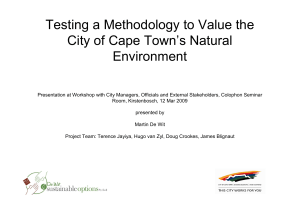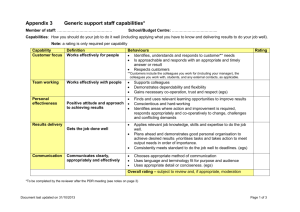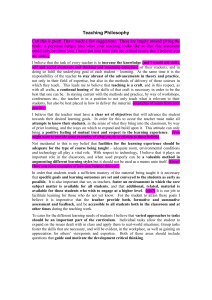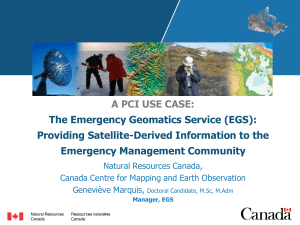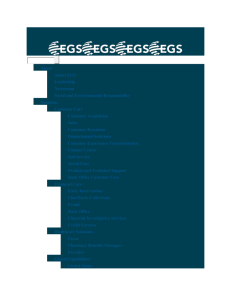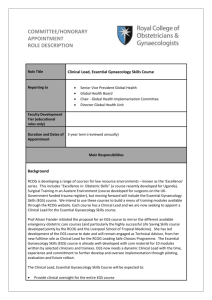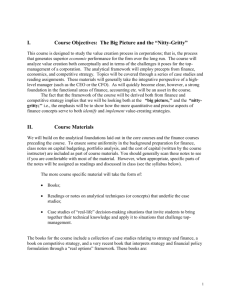Methodology to Value the Natural Assets
advertisement
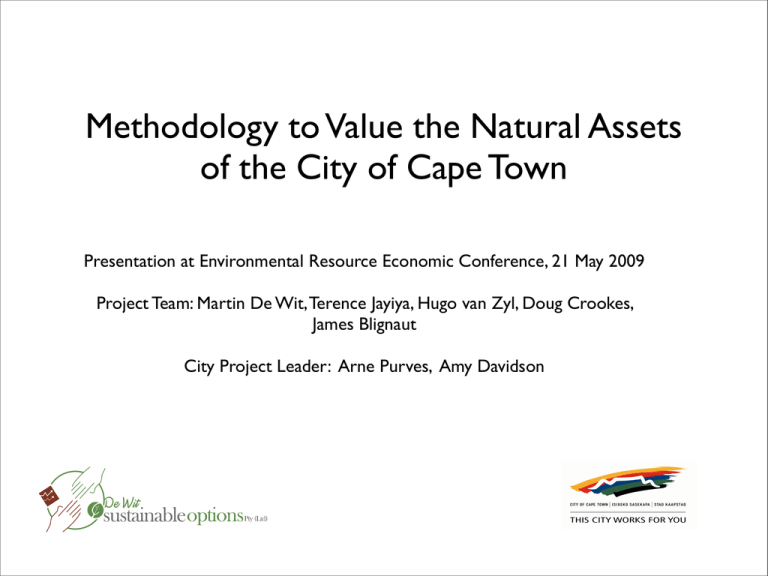
Methodology to Value the Natural Assets of the City of Cape Town Presentation at Environmental Resource Economic Conference, 21 May 2009 Project Team: Martin De Wit, Terence Jayiya, Hugo van Zyl, Doug Crookes, James Blignaut City Project Leader: Arne Purves, Amy Davidson Problem and rationale • In contrast to earlier development approaches and models, the steady supply of cheap natural and environmental resources cannot be taken for granted anymore, and in some cases have already become the limiting factor to further growth and development. • An argument on the economic value of Cape Town’s natural and environmental resources would contribute to shaping sustainable economic trajectories for the city. Purpose • The focus of the overall project is to influence budget allocations by developing focused economic arguments for investing, maintaining and expanding the City’s natural assets. • The development of a methodology is important as this allows for a clear and logically repeatable framework for the valuation and the building of a business case. • At the heart of the methodology is the need to prioritise assessment in order to optimise on both the return and the risks of using the City’s natural resources. • It is neither practical nor desirable to value all goods and services generated by natural assets in the City, necessitating a logical and replicable methodology for prioritising natural assets for valuation. Definitions • Natural assets are the stocks of environmental resources owned by the City (the City’s natural capital). • Environmental goods and services (EGS) are the flows of benefits derived from these assets (the interest or services generated by the capital). EGS and human well-being Why valuation? The fact that something is “valuable” does not in itself justify the decision to attempt to value it. The need to value the natural environment arises from the need to better integrate natural and social sciences in managing the natural environment and helping the policy-making process. Thus, valuation aims to provide means by which the contributions that the natural environment makes to human welfare can be better taken into account in decision-making procedures so that more efficient, effective and/or equitable decisions can be made. Source: Eftec, 2006. Valuing our Natural Environment. Final Report NR0103 for Department for Environment, Food and Rural Affairs. Project tasks Inventory of natural assets Flow of Ecosystems Goods and Services Prioritise Flows for the City Economic Value of Prioritised Flows Financial costbenefit modelling Increased investment in and maintenance of urban natural capital Business Case for the Environment Considerations in methodology development • Need broad scoping and comprehensive listing of the City’s natural assets and flows from these assets. • Focus on key EGS • Differentiate between an economic valuation technique and an economic valuation methodology • Link between specific natural assets and the specific flow ecosystem goods and services needs to be defined. • Links between different EGS and beneficiaries need to be clearly defined • Importance of EGS to socio-economic development needs to be clear • Better understand the chances of successful interventions - City management focus and environmental mandate • Ecosystem thresholds suggests that sustained supply of EGS need to be screened for ecological and resulting socio-economic risks 8 Six-step Methodology Identify levels of dependency: low value/ many (needy) people and high value/low number of people Users at different levels (municipality, region, national, global etc) Identify essential services and acceptable levels of service to meet legal standards, human needs and development objectives Services that are beyond municipal mandate cannot be controlled and should not be selected for study Prioritise those services that score high on ecological and socio-economic risk (signalling potential problems with a sustained flow of ecosystems goods and services and a potential high loss of social welfare) 9 Step 1: Natural Assets in the City Relative importance of natural assets as sources of EGS Natural areas & reserves Biota (fauna and flora) and soils Water environment Municipal parks Water courses, wetlands and dams Sports grounds Agricultural lands Vacant land Near shore coast Atmosphere Examples in the City: Blaauwberg Conservation Area False Bay Ecology Park City’s 23 nature reserves City Parks Freshwater river systems Coastal areas, incl. near shore Watercourses and wetlands 10 Flows of EGS Supporting services Photosynthesis Soil formation Primary production Nutrient cycling Water cycling Environmental goods and services Water regulation (flows, etc.) Natural hazard regualtion (floods, etc.) Water purification and waste treatment, assimilation Erosion regulation Pollination Regulating Disease regulation Pest regulation Climate regulation – local (air quality) Climate regulation – global Space for biota to live and reproduce (refugia) Fresh water provision Fuelwood provision Building materials provision (wood, sand, etc.) Wild flowers for harvesting Provision of plant and animal material for medicines and Provisioning biochemicals Provision of materials for crafts, fashion (e.g. shells) Fish and marine resources Genetic resources with potential pharmaceutical and other biochemical uses Small-scale urban farming Recreation and tourism Provision of inspirational beauty Aesthetic values and sense of place Educational uses (e.g. school excursions, scientific research) Cultural (information) Use in cultural and artistic practices and ceremonies Use in religion practices and ceremonies Use in productions (film and events), advertising and publications Beneficiary classification Local National/Regional Global Individual Local users (e.g. recreational users) Tourists, consumers, students Everyone (climate regulation, existence values) Commercial entity Local industry (e.g. entrepreneurs, farmers, traders, artisans) Economic sectors, national and regional GDP International enterprise (e.g. fishery and forestry industry) Public sector Local Government (e.g. tax revenue) National Government International (e.g. tax revenue, foreign Community revenue from sale of concessions) Source: based on Eftec, 2006. Valuing Our Natural Environment. Report prepared for Department for Environment, Food and Rural Affairs, United Kingdom. EGS & Beneficiaries in Cape Town Environmental goods and services (EGS) categories Beneficiaries/ users Primary local beneficiaries/users and relative importance of EGS to them Residents Key commercial enterprises R&S H,F&SEd C&R P L T&R F,A&E A&C RE C&MUA F Water Natural hazard Water and waste Erosion Regulating Pollination Supporting services Photosynthesis Soil formation Primary production Nutrient cycling Water cycling Disease Pest Air quality Climate Refugia Fresh water Fuel Building materials Wild flowers Provisioning Medicine Ornamental Fish and marine Genetic Urban agric Key public bodies Ec H&W DM W&W S&CN Reg Nat Int EGS and development objectives • Budget allocations are informed by the strategic objectives of the City’s Integrated Development Plan (IDP) • no specific high-level allocation to any specific environmental category. • EGS need to be ranked according to their impact on the IDP strategic focus areas. • Where key EGS are identified but not acknowledged in the IDP, a separate argument needs to be developed for the inclusion of these EGS in further planning updates. Strategic objectives in IDP: • Shared economic growth and development • Sustainable urban infrastructure and services • Energy efficiency for a sustainable future • Public transport systems • Integrated human settlements • Safety and security • Health, social and human capital development • Good governance and regulatory reform EGS and City mandate • Some assets and flows may – i) be almost completely under the control of the City, – ii) be shared with other institutions and groups, or – iii) fall completely outside of the City’s control. • Assets and flows completely outside of the City’s control will generally be less important when motivating for an increased allocation of financial resources. • The City is currently reviewing its environmental mandate (in terms of Constitution, assignment, delegation and agency agreements) – will most probably have an influence on where funds will be allocated and what organisations the City will partner with (eg CapeNature, SANPARKS) through intergovernmental agreements between different organs of state. • Implications: – “unauthorised expenditures” if no mandate - MFMA – Municipality as a service provider focussed on amongst others the nprovision of a safe and healthy environment EGS and risks • Experience shows that one cannot necessarily rely on natural assets to provide sustained flows of EGS and the economic values associated with them. • These are the environments where thresholds are important and exceeding these would have particularly onerous consequences in both ecological and socioeconomic terms. • The natural assets that could be on the brink of disaster and those that have a higher impact need to be given priority in assessment. • Ecosystem services can provide an important role in disaster risk management. – If this is not managed properly it also poses a major risk to infrastructure and service delivery. • Ecological risks to recreation and tourism include climatic changes and pollution. • Ranking or screening EGS according to the level of ecological and socio-economic risks they face is, therefore, an important step before devoting resources to valuation. 16 Testing the methodology • Prioritisation of EGS in the City was done in a participatory and facilitated workshop – City managers invited represented all functions related to environmental goods and services in the City. • environmental resources, parks, tourism, heritage, sports and recreation, wastewater, stormwater, solid waste and spatial planning • Participatory rapid assessment – focus groups – identify and shortly motivate most important linkages between all identified EGS in the City and • beneficiaries, • development objectives, • City’s environmental mandate and ability to influence and • ecological and socio-economic risks. • Formal evaluation was done after the workshop – each group’s discussion points, as contained in the minutes of the meeting, were used to rank importance within each of the four discussion focus areas in a spreadsheet matrix. 17 Methodology application Higher High Medium Low Natural hazard regulation Water purification and waste treatment, assimilation Space for biota Aesthetic values and sense of place Climate regulation – local (air quality) Climate regulation global Recreation and Tourism Small scale urban farming Fresh water provision Water regulation Building materials provision Fish and marine resources Provision of inspirational beauty Educational users Natural hazard regulation: Buffering ecosystems (e.g. reefs, kelp Cultural and artistic can reduce the impact of storms and large waves) practices Recreation and Tourism: People often choose their sites based Religious practices on the natural or cultivated characteristics of an area Erosion regulation Water purification and waste treatment, assimilation: Ecosystems can cause impurities but also help filter out and decompose organic wastes Space for biota: Regulation of habitat and space Aesthetic values and sense of place: Aesthetic values are reflected in support for parks, scenic drives and housing locations Disease regulation Harvesting Materials for craft and fashion Use in productions, advertising and publications Valuation application EGS Natural hazard regulation Valuation Technique Direct valuation techniques: Replacement Costs Notes to valuation argument Estimate damage costs: Infrastructure at risk (Flood, fire, storms, sea-level rise) frequency and severity Revealed WTP: Travel Costs Recreation and Tourism Expressed WTP: Contingent Valuation Existing TCM and CVM studies on value of beaches, recreation at wetlands, expressed importance of natural environment to tourism behaviour and thus expenditure Case study: Blue Flag beaches. Case study: Visits to nature reserves incl. educational groups Water purification and waste treatment, assimilation Natural environment can only cope with a certain maximum of waste. Services provided by the natural environment before this maximum is reach are essentially seen as a free service. Cost of fixing such ecological infrastructure is generally more than the costs of proactive management. Case studies: Milnerton and Zeekoeivlei Direct valuation techniques: Replacement Costs Space for biota (globally No specific EGS to be valued important biodiversity) Aesthetic values and sense of place Qualitative argument on the importance of biodiversity as an intermediate to the sustained provision of other EGS’s Cape Town’s natural asset allow for it to attract skilled entrepreneurs and others that help to drive economic development. Revealed WTP: Hedonic pricing Importance of Cape Town branding (clean city) reflected in human capital and Rely on existing research on how the natural environment adds to property values property values can also be consolidated to show this value. Case study on film and advertising industry Illustrative simplistic business case Natural Assets Environmental Values (Rm pa, 2007) Environmental resources >274 City expenditure (Rm, 2007/8, OPEX + CAPEX 64 Wetlands 180 .. Nature Reserves 39 .. Beaches 55 .. .. .. .. Agricultural fields 95 0 Other expenditure Benefit: Cost (2007) ?? >4.3 Note: Static analysis for illustrative purposes only. Conclusion • Robust, tested methodology to value the natural assets of the City of Cape Town: – Best available national and international literature – Inputs local experts – Two external reviews – Participatory testing with city managers • Prioritised environmental services for further work – Valuation case study used as demonstration – Based on inputs from city managers • Basis for further development business case – budgeting process and timing – rules of allocation – organisational functions – randomly determined influences 21
